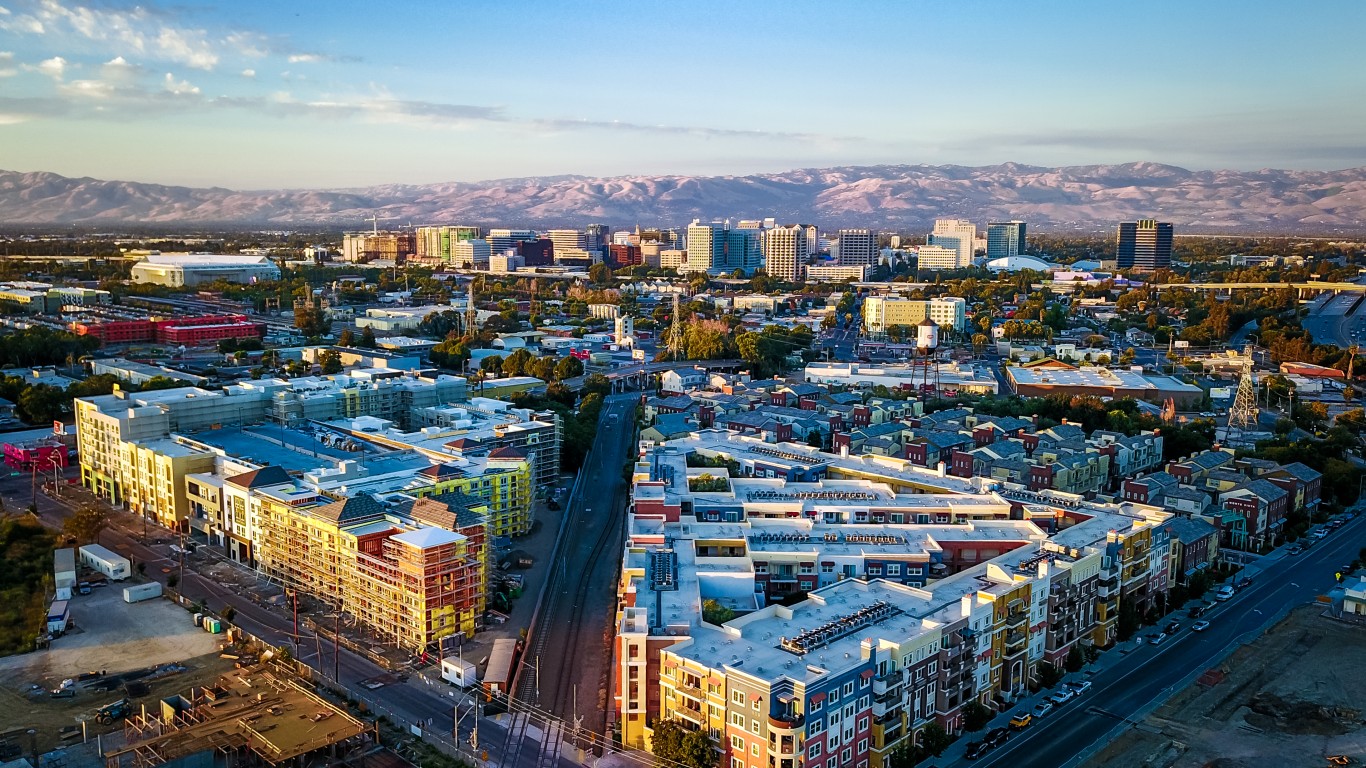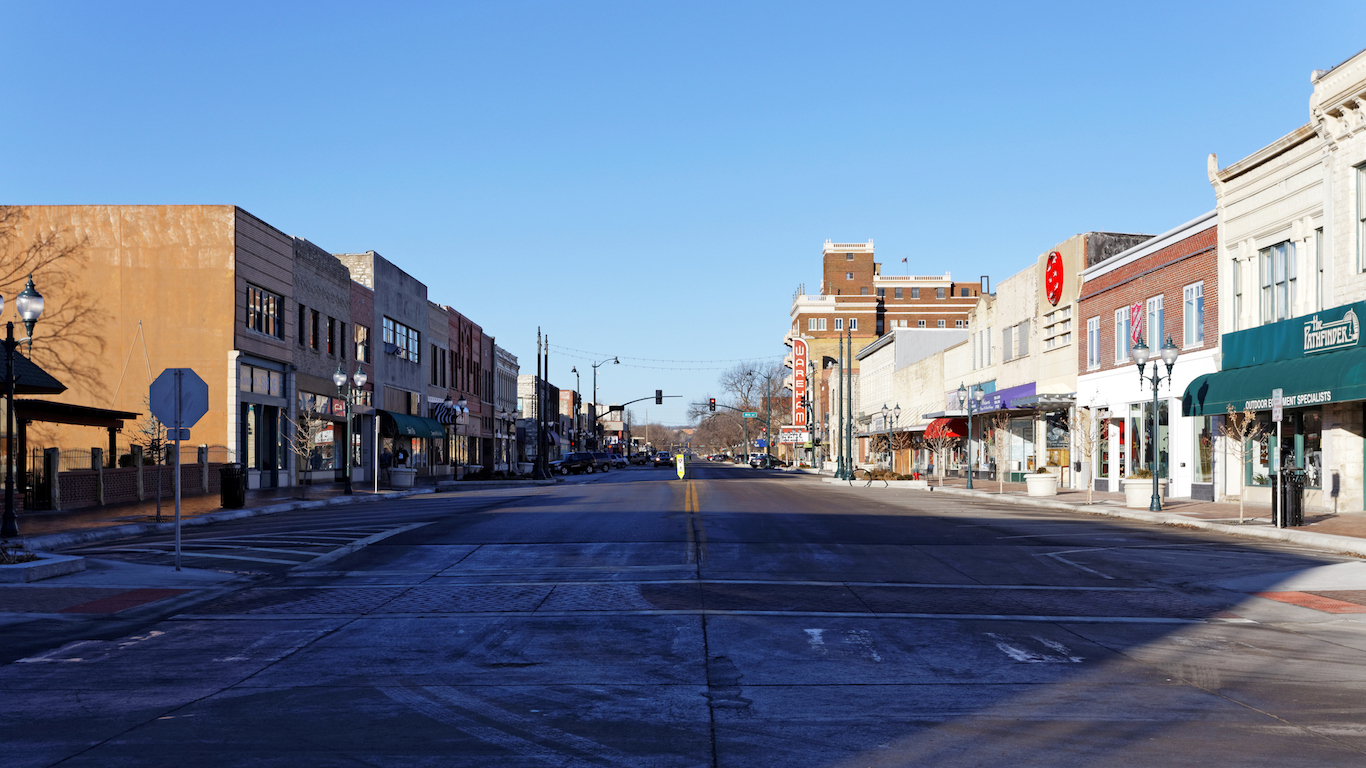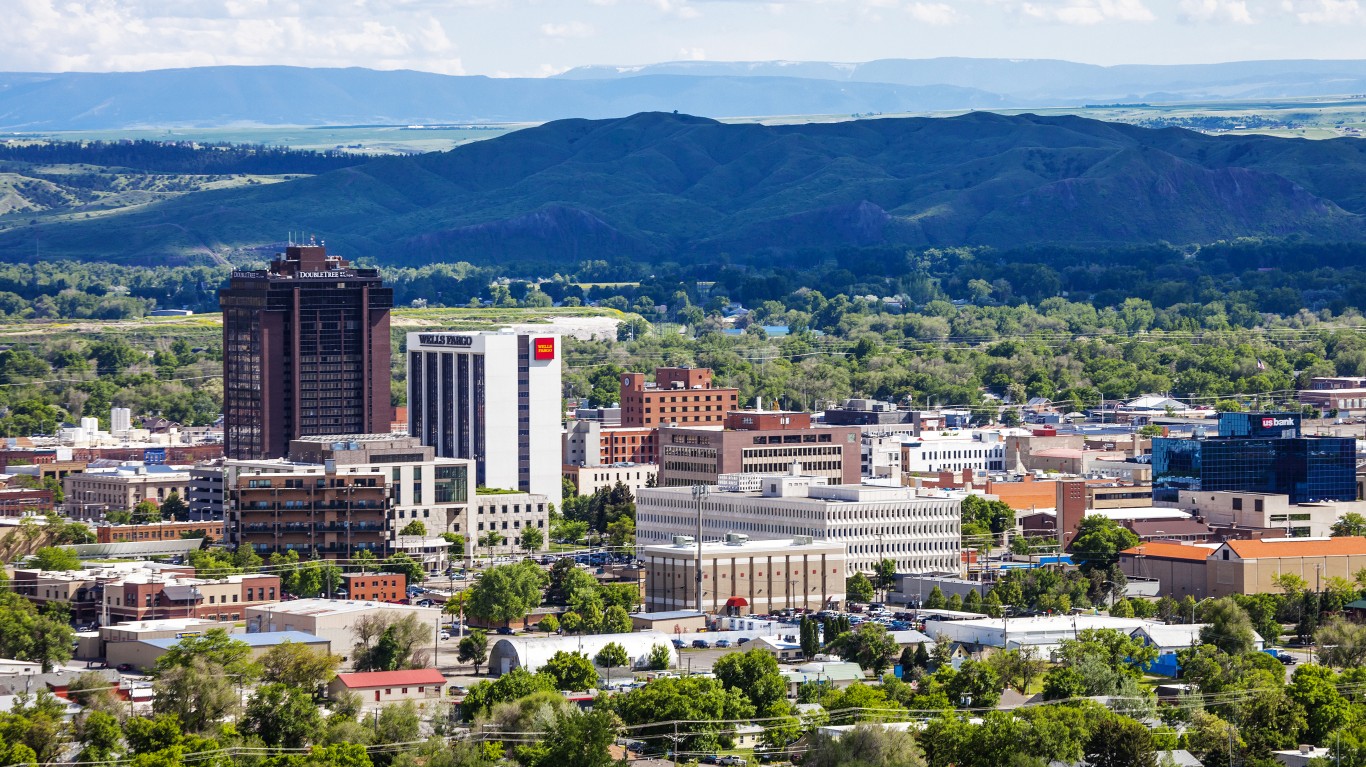Special Report
Every State's Unemployment Claims Since COVID-19 Shut the Economy Down

Published:
Last Updated:

Weekly jobless claims climbed by 3.5 million, bringing the total number of unemployment claims since mid-March to nearly 28 million. The latest round of layoffs suggests the unemployment rate could be approaching 25% — a level not seen since the height of the Great Depression.
As unemployment claims continue to surge by the millions with each passing week, 24/7 Wall St. has been compiling a state-by-state review of jobless claims. Job losses by state range from the tens of thousands to the millions over the five weeks beginning on March 15, amounting to anywhere from 7% to nearly 30% of each state’s total workforce. Over the most recent week of data, April 19 to April 25, unemployment claims were anywhere from five to 73 times higher than what they were in the same week last year, depending on the state.
The current economic downturn is largely attributable to efforts to contain the spread of the coronavirus. Elected officials across the country have heeded advice from health experts and instituted a range of measures to facilitate social distancing, from shelter-in-place orders to closing nonessential businesses. These measures, however, have taken a toll on the economy. Here is a state-by-state look at social distancing rules.
The states where unemployment rates are projected to be the highest in the coming months tend to be those that rely on industries that will likely bear the brunt of the current economic downturn. These industries include leisure and hospitality, travel services, transportation and warehousing, and oil and gas extraction. Americans who have been laid off in these and other industries face economic uncertainty, both short- and long-term. Here is what you can do if coronavirus is threatening your retirement.
Click here to see every state’s unemployment claims since COVID-19 shut the economy down
Click here to read our methodology

Alabama
> Unemployment claims since mid-March: 406,732 (18.1% of workforce)
> Most recent week’s unemployment claims (April 19 – April 25): 64,170 (18th most)
> Change in weekly claims from one year ago: +62,250 (+3,242%)
> Pct. of workers in high-risk industries: 16.8% (21st lowest)
> Projected unemployment rate, July 2020: 14.5% (6th lowest)
[in-text-ad]

Alaska
> Unemployment claims since mid-March: 71,606 (20.7% of workforce)
> Most recent week’s unemployment claims (April 19 – April 25): 11,187 (10th fewest)
> Change in weekly claims from one year ago: +10,324 (+1,196%)
> Pct. of workers in high-risk industries: 21.8% (4th highest)
> Projected unemployment rate, July 2020: 17.8% (3rd highest)

Arizona
> Unemployment claims since mid-March: 473,802 (13.5% of workforce)
> Most recent week’s unemployment claims (April 19 – April 25): 52,098 (22nd most)
> Change in weekly claims from one year ago: +46,795 (+882%)
> Pct. of workers in high-risk industries: 19.3% (15th highest)
> Projected unemployment rate, July 2020: 15.4% (24th lowest)

Arkansas
> Unemployment claims since mid-March: 176,895 (13.0% of workforce)
> Most recent week’s unemployment claims (April 19 – April 25): 16,745 (15th fewest)
> Change in weekly claims from one year ago: +15,408 (+1,152%)
> Pct. of workers in high-risk industries: 17.0% (23rd lowest)
> Projected unemployment rate, July 2020: 15.3% (22nd lowest)
[in-text-ad-2]

California
> Unemployment claims since mid-March: 3.7 million (18.9% of workforce)
> Most recent week’s unemployment claims (April 19 – April 25): 328,042 (2nd most)
> Change in weekly claims from one year ago: +287,730 (+714%)
> Pct. of workers in high-risk industries: 17.9% (22nd highest)
> Projected unemployment rate, July 2020: 15.6% (19th highest)

Colorado
> Unemployment claims since mid-March: 338,516 (10.9% of workforce)
> Most recent week’s unemployment claims (April 19 – April 25): 38,367 (23rd fewest)
> Change in weekly claims from one year ago: +36,422 (+1,873%)
> Pct. of workers in high-risk industries: 18.6% (19th highest)
> Projected unemployment rate, July 2020: 14.1% (4th lowest)
[in-text-ad]

Connecticut
> Unemployment claims since mid-March: 261,686 (13.8% of workforce)
> Most recent week’s unemployment claims (April 19 – April 25): 33,037 (20th fewest)
> Change in weekly claims from one year ago: +27,352 (+481%)
> Pct. of workers in high-risk industries: 14.2% (the lowest)
> Projected unemployment rate, July 2020: 14.8% (10th lowest)

Delaware
> Unemployment claims since mid-March: 79,222 (16.4% of workforce)
> Most recent week’s unemployment claims (April 19 – April 25): 7,754 (7th fewest)
> Change in weekly claims from one year ago: +6,619 (+583%)
> Pct. of workers in high-risk industries: 17.0% (22nd lowest)
> Projected unemployment rate, July 2020: 16.8% (6th highest)

Florida
> Unemployment claims since mid-March: 1.6 million (15.5% of workforce)
> Most recent week’s unemployment claims (April 19 – April 25): 432,465 (the most)
> Change in weekly claims from one year ago: +426,565 (+7,230%)
> Pct. of workers in high-risk industries: 20.1% (6th highest)
> Projected unemployment rate, July 2020: 15.5% (24th highest)
[in-text-ad-2]

Georgia
> Unemployment claims since mid-March: 1.4 million (26.8% of workforce)
> Most recent week’s unemployment claims (April 19 – April 25): 264,818 (3rd most)
> Change in weekly claims from one year ago: +260,361 (+5,842%)
> Pct. of workers in high-risk industries: 19.7% (9th highest)
> Projected unemployment rate, July 2020: 14.9% (11th lowest)

Hawaii
> Unemployment claims since mid-March: 194,437 (29.2% of workforce)
> Most recent week’s unemployment claims (April 19 – April 25): 22,615 (16th fewest)
> Change in weekly claims from one year ago: +21,341 (+1,675%)
> Pct. of workers in high-risk industries: 27.1% (2nd highest)
> Projected unemployment rate, July 2020: 17.8% (3rd highest)
[in-text-ad]

Idaho
> Unemployment claims since mid-March: 117,253 (13.5% of workforce)
> Most recent week’s unemployment claims (April 19 – April 25): 8,268 (9th fewest)
> Change in weekly claims from one year ago: +7,484 (+955%)
> Pct. of workers in high-risk industries: 16.1% (16th lowest)
> Projected unemployment rate, July 2020: 14.0% (3rd lowest)

Illinois
> Unemployment claims since mid-March: 818,917 (12.7% of workforce)
> Most recent week’s unemployment claims (April 19 – April 25): 81,245 (12th most)
> Change in weekly claims from one year ago: +73,935 (+1,011%)
> Pct. of workers in high-risk industries: 18.8% (17th highest)
> Projected unemployment rate, July 2020: 15.6% (19th highest)

Indiana
> Unemployment claims since mid-March: 569,847 (16.8% of workforce)
> Most recent week’s unemployment claims (April 19 – April 25): 57,397 (19th most)
> Change in weekly claims from one year ago: +55,197 (+2,509%)
> Pct. of workers in high-risk industries: 18.0% (21st highest)
> Projected unemployment rate, July 2020: 15.0% (16th lowest)
[in-text-ad-2]

Iowa
> Unemployment claims since mid-March: 260,729 (15.2% of workforce)
> Most recent week’s unemployment claims (April 19 – April 25): 28,827 (18th fewest)
> Change in weekly claims from one year ago: +26,830 (+1,344%)
> Pct. of workers in high-risk industries: 14.9% (3rd lowest)
> Projected unemployment rate, July 2020: 14.2% (5th lowest)

Kansas
> Unemployment claims since mid-March: 215,722 (14.6% of workforce)
> Most recent week’s unemployment claims (April 19 – April 25): 28,054 (17th fewest)
> Change in weekly claims from one year ago: +26,783 (+2,107%)
> Pct. of workers in high-risk industries: 15.8% (14th lowest)
> Projected unemployment rate, July 2020: 14.7% (8th lowest)
[in-text-ad]

Kentucky
> Unemployment claims since mid-March: 590,829 (28.7% of workforce)
> Most recent week’s unemployment claims (April 19 – April 25): 90,824 (9th most)
> Change in weekly claims from one year ago: +89,108 (+5,193%)
> Pct. of workers in high-risk industries: 19.4% (13th highest)
> Projected unemployment rate, July 2020: 16.3% (10th highest)

Louisiana
> Unemployment claims since mid-March: 508,202 (24.4% of workforce)
> Most recent week’s unemployment claims (April 19 – April 25): 66,167 (16th most)
> Change in weekly claims from one year ago: +64,137 (+3,159%)
> Pct. of workers in high-risk industries: 19.5% (12th highest)
> Projected unemployment rate, July 2020: 18.0% (2nd highest)

Maine
> Unemployment claims since mid-March: 108,874 (15.9% of workforce)
> Most recent week’s unemployment claims (April 19 – April 25): 7,478 (6th fewest)
> Change in weekly claims from one year ago: +6,758 (+939%)
> Pct. of workers in high-risk industries: 15.1% (8th lowest)
> Projected unemployment rate, July 2020: 15.7% (17th highest)
[in-text-ad-2]

Maryland
> Unemployment claims since mid-March: 385,657 (11.9% of workforce)
> Most recent week’s unemployment claims (April 19 – April 25): 36,471 (22nd fewest)
> Change in weekly claims from one year ago: +33,939 (+1,340%)
> Pct. of workers in high-risk industries: 15.7% (12th lowest)
> Projected unemployment rate, July 2020: 13.9% (the lowest)

Massachusetts
> Unemployment claims since mid-March: 725,018 (19.1% of workforce)
> Most recent week’s unemployment claims (April 19 – April 25): 70,714 (15th most)
> Change in weekly claims from one year ago: +66,070 (+1,423%)
> Pct. of workers in high-risk industries: 15.0% (6th lowest)
> Projected unemployment rate, July 2020: 15.1% (18th lowest)
[in-text-ad]

Michigan
> Unemployment claims since mid-March: 1.3 million (25.6% of workforce)
> Most recent week’s unemployment claims (April 19 – April 25): 81,312 (11th most)
> Change in weekly claims from one year ago: +76,621 (+1,633%)
> Pct. of workers in high-risk industries: 16.4% (17th lowest)
> Projected unemployment rate, July 2020: 15.2% (21st lowest)

Minnesota
> Unemployment claims since mid-March: 556,651 (18.0% of workforce)
> Most recent week’s unemployment claims (April 19 – April 25): 53,561 (20th most)
> Change in weekly claims from one year ago: +50,894 (+1,908%)
> Pct. of workers in high-risk industries: 14.9% (4th lowest)
> Projected unemployment rate, July 2020: 15.0% (16th lowest)

Mississippi
> Unemployment claims since mid-March: 201,890 (15.9% of workforce)
> Most recent week’s unemployment claims (April 19 – April 25): 35,843 (21st fewest)
> Change in weekly claims from one year ago: +34,146 (+2,012%)
> Pct. of workers in high-risk industries: 19.1% (16th highest)
> Projected unemployment rate, July 2020: 17.5% (5th highest)
[in-text-ad-2]

Missouri
> Unemployment claims since mid-March: 452,126 (14.8% of workforce)
> Most recent week’s unemployment claims (April 19 – April 25): 52,403 (21st most)
> Change in weekly claims from one year ago: +50,006 (+2,086%)
> Pct. of workers in high-risk industries: 16.6% (19th lowest)
> Projected unemployment rate, July 2020: 15.7% (17th highest)

Montana
> Unemployment claims since mid-March: 89,426 (17.0% of workforce)
> Most recent week’s unemployment claims (April 19 – April 25): 6,619 (4th fewest)
> Change in weekly claims from one year ago: +5,763 (+673%)
> Pct. of workers in high-risk industries: 19.4% (14th highest)
> Projected unemployment rate, July 2020: 16.3% (10th highest)
[in-text-ad]

Nebraska
> Unemployment claims since mid-March: 104,177 (10.2% of workforce)
> Most recent week’s unemployment claims (April 19 – April 25): 8,197 (8th fewest)
> Change in weekly claims from one year ago: +7,700 (+1,549%)
> Pct. of workers in high-risk industries: 15.7% (11th lowest)
> Projected unemployment rate, July 2020: 15.1% (18th lowest)

Nevada
> Unemployment claims since mid-March: 386,705 (25.2% of workforce)
> Most recent week’s unemployment claims (April 19 – April 25): 45,043 (25th most)
> Change in weekly claims from one year ago: +42,767 (+1,879%)
> Pct. of workers in high-risk industries: 33.5% (the highest)
> Projected unemployment rate, July 2020: 19.7% (the highest)

New Hampshire
> Unemployment claims since mid-March: 159,993 (20.8% of workforce)
> Most recent week’s unemployment claims (April 19 – April 25): 14,347 (14th fewest)
> Change in weekly claims from one year ago: +13,484 (+1,562%)
> Pct. of workers in high-risk industries: 15.1% (9th lowest)
> Projected unemployment rate, July 2020: 15.0% (16th lowest)
[in-text-ad-2]

New Jersey
> Unemployment claims since mid-March: 889,480 (19.9% of workforce)
> Most recent week’s unemployment claims (April 19 – April 25): 71,017 (14th most)
> Change in weekly claims from one year ago: +57,239 (+415%)
> Pct. of workers in high-risk industries: 17.4% (24th highest)
> Projected unemployment rate, July 2020: 15.6% (19th highest)

New Mexico
> Unemployment claims since mid-March: 118,462 (12.5% of workforce)
> Most recent week’s unemployment claims (April 19 – April 25): 13,712 (13th fewest)
> Change in weekly claims from one year ago: +12,995 (+1,812%)
> Pct. of workers in high-risk industries: 18.8% (18th highest)
> Projected unemployment rate, July 2020: 16.2% (14th highest)
[in-text-ad]

New York
> Unemployment claims since mid-March: 1.6 million (16.9% of workforce)
> Most recent week’s unemployment claims (April 19 – April 25): 218,912 (5th most)
> Change in weekly claims from one year ago: +200,332 (+1,078%)
> Pct. of workers in high-risk industries: 15.1% (7th lowest)
> Projected unemployment rate, July 2020: 16.4% (8th highest)

North Carolina
> Unemployment claims since mid-March: 747,303 (14.8% of workforce)
> Most recent week’s unemployment claims (April 19 – April 25): 97,232 (8th most)
> Change in weekly claims from one year ago: +94,398 (+3,331%)
> Pct. of workers in high-risk industries: 17.6% (23rd highest)
> Projected unemployment rate, July 2020: 15.5% (24th highest)

North Dakota
> Unemployment claims since mid-March: 57,168 (14.3% of workforce)
> Most recent week’s unemployment claims (April 19 – April 25): 6,996 (5th fewest)
> Change in weekly claims from one year ago: +6,683 (+2,135%)
> Pct. of workers in high-risk industries: 19.8% (8th highest)
> Projected unemployment rate, July 2020: 15.6% (19th highest)
[in-text-ad-2]

Ohio
> Unemployment claims since mid-March: 1.1 million (18.3% of workforce)
> Most recent week’s unemployment claims (April 19 – April 25): 90,760 (10th most)
> Change in weekly claims from one year ago: +85,101 (+1,504%)
> Pct. of workers in high-risk industries: 17.0% (24th lowest)
> Projected unemployment rate, July 2020: 16.4% (8th highest)

Oklahoma
> Unemployment claims since mid-March: 273,958 (14.9% of workforce)
> Most recent week’s unemployment claims (April 19 – April 25): 42,577 (24th fewest)
> Change in weekly claims from one year ago: +40,567 (+2,018%)
> Pct. of workers in high-risk industries: 19.9% (7th highest)
> Projected unemployment rate, July 2020: 14.7% (8th lowest)
[in-text-ad]

Oregon
> Unemployment claims since mid-March: 278,852 (13.3% of workforce)
> Most recent week’s unemployment claims (April 19 – April 25): 46,722 (24th most)
> Change in weekly claims from one year ago: +43,447 (+1,327%)
> Pct. of workers in high-risk industries: 16.4% (18th lowest)
> Projected unemployment rate, July 2020: 15.5% (24th highest)

Pennsylvania
> Unemployment claims since mid-March: 1.6 million (25.2% of workforce)
> Most recent week’s unemployment claims (April 19 – April 25): 131,282 (7th most)
> Change in weekly claims from one year ago: +119,465 (+1,011%)
> Pct. of workers in high-risk industries: 16.7% (20th lowest)
> Projected unemployment rate, July 2020: 16.6% (7th highest)

Rhode Island
> Unemployment claims since mid-March: 145,615 (26.4% of workforce)
> Most recent week’s unemployment claims (April 19 – April 25): 13,138 (12th fewest)
> Change in weekly claims from one year ago: +12,020 (+1,075%)
> Pct. of workers in high-risk industries: 17.1% (25th highest)
> Projected unemployment rate, July 2020: 15.4% (24th lowest)
[in-text-ad-2]

South Carolina
> Unemployment claims since mid-March: 413,542 (17.5% of workforce)
> Most recent week’s unemployment claims (April 19 – April 25): 65,159 (17th most)
> Change in weekly claims from one year ago: +63,040 (+2,975%)
> Pct. of workers in high-risk industries: 19.6% (10th highest)
> Projected unemployment rate, July 2020: 15.0% (16th lowest)

South Dakota
> Unemployment claims since mid-March: 33,743 (7.4% of workforce)
> Most recent week’s unemployment claims (April 19 – April 25): 5,389 (3rd fewest)
> Change in weekly claims from one year ago: +5,263 (+4,177%)
> Pct. of workers in high-risk industries: 14.5% (2nd lowest)
> Projected unemployment rate, July 2020: 15.8% (15th highest)
[in-text-ad]

Tennessee
> Unemployment claims since mid-March: 425,668 (12.8% of workforce)
> Most recent week’s unemployment claims (April 19 – April 25): 43,792 (25th fewest)
> Change in weekly claims from one year ago: +41,686 (+1,979%)
> Pct. of workers in high-risk industries: 20.3% (5th highest)
> Projected unemployment rate, July 2020: 15.8% (15th highest)

Texas
> Unemployment claims since mid-March: 1.6 million (11.1% of workforce)
> Most recent week’s unemployment claims (April 19 – April 25): 254,199 (4th most)
> Change in weekly claims from one year ago: +242,115 (+2,004%)
> Pct. of workers in high-risk industries: 19.6% (11th highest)
> Projected unemployment rate, July 2020: 15.2% (21st lowest)

Utah
> Unemployment claims since mid-March: 136,778 (8.6% of workforce)
> Most recent week’s unemployment claims (April 19 – April 25): 11,830 (11th fewest)
> Change in weekly claims from one year ago: +10,824 (+1,076%)
> Pct. of workers in high-risk industries: 17.0% (25th lowest)
> Projected unemployment rate, July 2020: 14.8% (10th lowest)
[in-text-ad-2]

Vermont
> Unemployment claims since mid-March: 56,122 (16.3% of workforce)
> Most recent week’s unemployment claims (April 19 – April 25): 4,971 (2nd fewest)
> Change in weekly claims from one year ago: +4,308 (+650%)
> Pct. of workers in high-risk industries: 15.4% (10th lowest)
> Projected unemployment rate, July 2020: 15.0% (16th lowest)

Virginia
> Unemployment claims since mid-March: 567,534 (13.0% of workforce)
> Most recent week’s unemployment claims (April 19 – April 25): 74,043 (13th most)
> Change in weekly claims from one year ago: +71,981 (+3,491%)
> Pct. of workers in high-risk industries: 15.7% (13th lowest)
> Projected unemployment rate, July 2020: 14.0% (3rd lowest)
[in-text-ad]

Washington
> Unemployment claims since mid-March: 857,697 (22.1% of workforce)
> Most recent week’s unemployment claims (April 19 – April 25): 145,757 (6th most)
> Change in weekly claims from one year ago: +140,422 (+2,632%)
> Pct. of workers in high-risk industries: 15.0% (5th lowest)
> Projected unemployment rate, July 2020: 15.2% (21st lowest)

West Virginia
> Unemployment claims since mid-March: 123,828 (15.7% of workforce)
> Most recent week’s unemployment claims (April 19 – April 25): 29,576 (19th fewest)
> Change in weekly claims from one year ago: +28,644 (+3,073%)
> Pct. of workers in high-risk industries: 18.2% (20th highest)
> Projected unemployment rate, July 2020: 16.3% (10th highest)

Wisconsin
> Unemployment claims since mid-March: 442,581 (14.3% of workforce)
> Most recent week’s unemployment claims (April 19 – April 25): 49,910 (23rd most)
> Change in weekly claims from one year ago: +45,019 (+920%)
> Pct. of workers in high-risk industries: 15.8% (15th lowest)
> Projected unemployment rate, July 2020: 15.6% (19th highest)
[in-text-ad-2]

Wyoming
> Unemployment claims since mid-March: 29,653 (10.3% of workforce)
> Most recent week’s unemployment claims (April 19 – April 25): 2,886 (the fewest)
> Change in weekly claims from one year ago: +2,600 (+909%)
> Pct. of workers in high-risk industries: 25.5% (3rd highest)
> Projected unemployment rate, July 2020: 16.3% (10th highest)
Methodology
To determine the number of unemployment claims in each state, 24/7 Wall St. reviewed the total initial unemployment claims for each week from the week ending March 21, 2020, through the week ending April 25, 2020 — a total of six weeks. Unemployment claims figures are not seasonally adjusted and are from the Department of Labor.
To calculate unemployment claims from March 15 through April 25 as a share of each state’s labor force, we used the unadjusted number of claims over that six week period and the total size of the labor force (not seasonally adjusted) as of February 2020 from the Bureau of Labor Statistics Current Employment Statistics.
The identification of high-risk industries comes from a March 2020 paper, “COVID-19: A Fiscal Stimulus Plan,” published by Moody’s Analytics, an economic research company. Employment data by industry came from the Bureau of Labor Statistics’ Quarterly Census of Employment and Wages and are annual estimates for 2018.
The projected unemployment rate by state for July 2020 came from a report published on April 1 by the Economic Policy Institute, a nonpartisan, nonprofit think tank.
If you’re one of the over 4 Million Americans set to retire this year, you may want to pay attention. Many people have worked their whole lives preparing to retire without ever knowing the answer to the most important question: am I ahead, or behind on my goals?
Don’t make the same mistake. It’s an easy question to answer. A quick conversation with a financial advisor can help you unpack your savings, spending, and goals for your money. With Zoe Financial’s free matching tool, you can connect with trusted financial advisors in minutes.
Why wait? Click here to get started today!
Thank you for reading! Have some feedback for us?
Contact the 24/7 Wall St. editorial team.